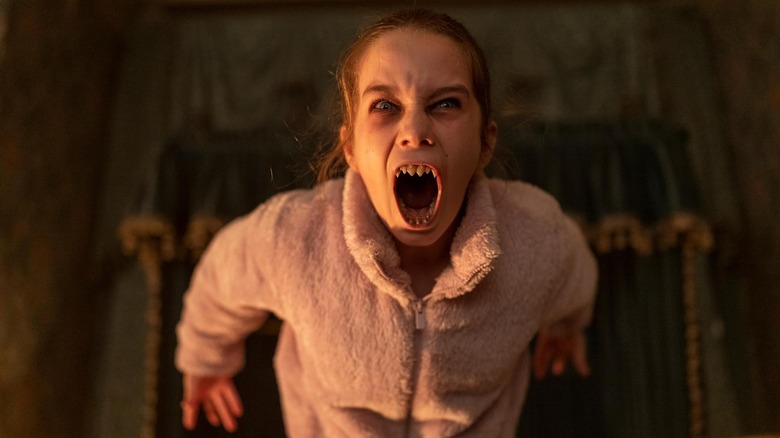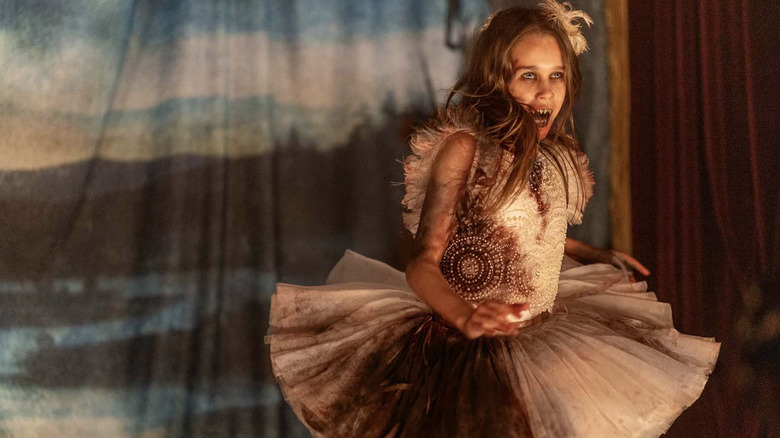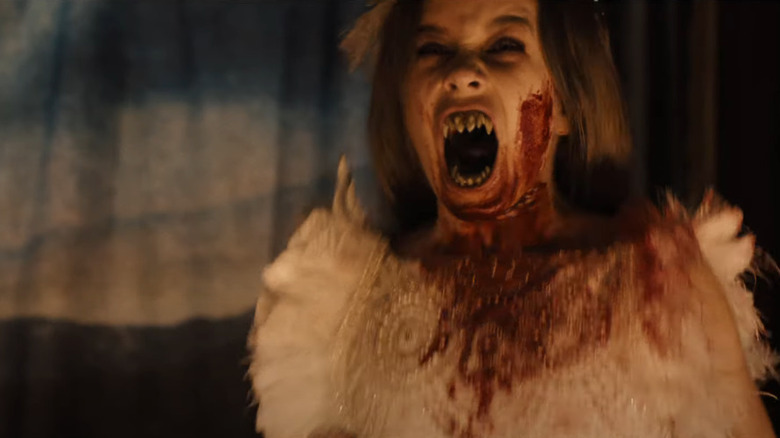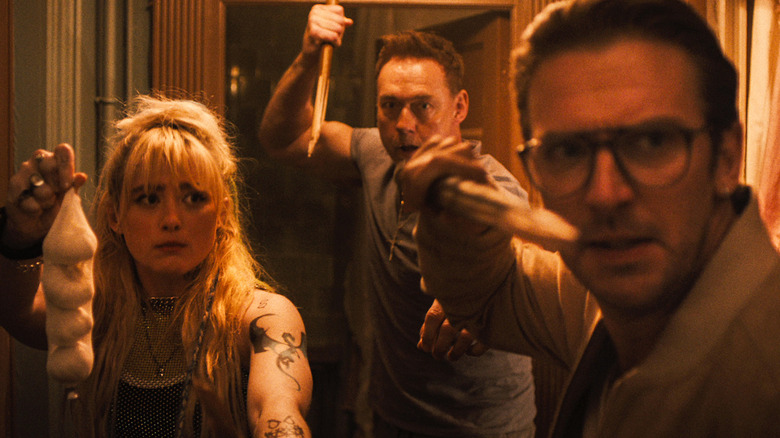The Vampire Rules In Abigail (And How They Change The Horror Game) Explained
This article contains massive spoilers for "Abigail."
"Abigail" features a group of six mercenaries (played by Melissa Barrera, Dan Stevens, Kathryn Newton, Kevin Durand, Will Catlett, and the late Angus Cloud) holding the eponymous girl (Alisha Weir) hostage in a manor. Who's really in the mousetrap here, though?
The trailer gave it all away, but Abigail is a vampire and has brought this group of six together for a feast — one they won't be leaving. It's like the inversion of directors Matt Bettinelli-Olpin and Tyler Gillett's previous mansion survival thriller, "Ready or Not." In that one, Grace (Samara Weaving), recently married into the wealthy Le Domas family, has to dodge her new in-laws as they play the most dangerous game. In "Abigail," a single, seemingly fragile girl hunts a group of people.
Bettinelli-Olpin and Gillett previously directed "Scream" V and VI (Barrera starred in those movies before she was fired from "Scream" VII for pro-Palestine posts); "Abigail" inherits the meta-horror touch of "Scream." When the characters find out what Abigail is, they immediately brainstorm on how to kill a vampire. Sammy (Newton) mentions they have to consider what type of vampire: Anne Rice, "True Blood," or "Twilight." Vampires aren't real (I hope) and so in different stories, the rules surrounding their strengths and weaknesses diverge.
Here's how "Abigail" compares.
Abigail's vampire strengths
Vampires are typically ageless immortals and that's true here too; Abigail looks 12 years old but was turned centuries ago. Other common vampire abilities include enhanced strength, shapeshifting (into bats, wolves, or intangible mist), glamour (psychically influencing someone), and flight. Most of these go back to "Dracula" and the Count's nebulous powers in that book.
One of my favorite new fantasy book series, "Empire of the Vampire" by Jay Kristoff, acknowledges the powers and spreads them out among five vampire bloodlines: Dyvok (super strong), Chastain (control of animals), Illon (glamour), Voss (unbreakable skin + mind control), and Esana (telekinetic control of blood).
Abigail shows strength (she tosses around the 6'6" Peter, played by Durand), glamour, and flight, but no shapeshifting. Her glamour also specifically extends to Sammy after she bites and turns her.
Therein lies another wrinkle about the film's vampire mythology; the "siring" process. To become a full-fledged vampire in "Abigail," one must let a vampire drain their blood and then drink the vampire's blood in turn. This is how it usually works in vampire stories (again, because that's how "Dracula" did it), but "Abigail" adds another wrinkle. If new vampires don't drink their maker's blood after being bitten, then they become a mere puppet, a vampire with no free will beyond their sire's; this is the fate that befalls Sammy.
Abigail's vampire faces
While vampire bites in "Abigail" make humans into vampires, the process requires intention. Abigail tells a turned Frank (Stevens) that "It takes a long time to learn how to do all the cool s**t" after he tries to make Joey (Barrera) into his puppet. Like in many other stories, "puppet" vampires can be freed (or the gradual transformation forestalled) by killing the vampire who first bit the "puppet." Once Frank is killed, Abigail reassures Joey she won't become a vampire despite being bitten, especially since she didn't drink Frank's blood for a complete transformation.
Speaking of vampire bites, it's common to depict vampires as literally two-faced, with a human face for stalking and a monstrous, fanged face for feeding; see "Buffy: The Vampire Slayer" and "The Lost Boys." As James Marsters (Spike on "Buffy") noted, this allows vampires to be both sexy and horrific in separate scenes.
"Abigail" does this too, but the transformation is mostly limited to the mouth (unlike "Buffy" where vampires have yellow eyes and bumpy foreheads). Rather than two shapely canine fangs, the vampires in "Abigail" have uneven rows of sharp teeth, like a great white shark.
Abigail's vampire weaknesses
Now, as for vampire weaknesses: the typical ones (namechecked in the movie) are garlic, crucifixes and holy water (because unholy abominations burn in the eye of God), exposure to sunlight, and wooden stakes through the heart. "Abigail" goes 50/50; garlic and crosses have no effect on vampires (Abigail even repeatedly stabs Peter with his cross necklace). Sunlight and stakes, though? Those work.
Vampires' vulnerability to sunlight originates in 1922's "Nosferatu," where Count Orlok (Max Schreck) is defeated by the sunrise. In "Buffy," vampires catch fire in the sun, while in "Twilight," sunlight just makes their skin glimmer. In "Abigail," sunlight is anathema to vampires; they don't just burn in it, it makes their bodies implode upon contact. When Abigail sticks her arm into the sun, it blows up and she recoils; from there, her arm slowly grows back, showing sunlight has to completely destroy the vampire to override their healing. Exploding seems to be the automatic reflex to a vampire's corpse ("Buffy," meanwhile, depicted them crumbling into bloodless dust upon death). The vampire Frank explodes after being staked through the heart — no sunlight necessary.
The importance of the heart in defeating a vampire reflects another weakness "Abigail" introduces to vampires. Instead of being totally undead, vampires still have heart pulses, and thus bodily circulation. This means that when Joey administers a sedative to Abigail, it knocks her out like it would a human. This is also presumably why, in "Abigail," vampires can drink the blood of other vampires (because their hearts are still pumping it). However, as Abigail tells Frank, a vampire needs to be completely drained to die of blood loss. "Abigail" was made by people familiar with the rules of vampires, and thus knew which ones they wanted to follow.
"Abigail" is playing in theaters.



